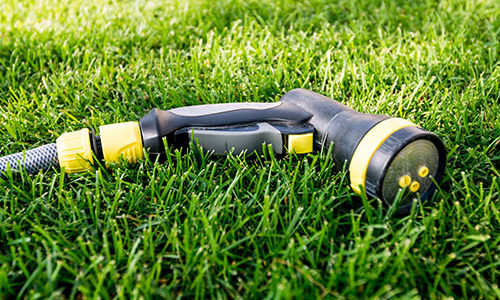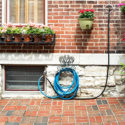Canadians spend so much of the year dealing with freezing and inclement weather that we all long for summer. However, when it finally arrives, the warmer months can bring issues for homeowners and gardening enthusiasts.Canadians spend so much of the year dealing with freezing and inclement weather that we all long for summer. However, when it finally arrives, the warmer months can bring issues for homeowners and gardening enthusiasts.
Here are 10 summer lawn care tips and solutions; 5 for your lawn and 5 for your garden.
Top 5 Summer Lawn Concerns
1. Drought
It seems like one summer we have too much rain, and the next summer not enough. Drought can be a real problem, especially if your town puts restrictions on water use. Fortunately, there are things you can do to help your lawn survive.
If the forecast calls for a dry spell, stop fertilizing and start watering the grass deeply and infrequently. You should also mow often so you never remove more than the top third of the blades of grass, and leave the clippings on the lawn. This will help prepare your lawn in the event of a drought.
During a drought, you should reduce foot traffic and let your grass grow taller. Raise your mower blades and cut the grass to 3-4 inches. Longer grass will create a shading effect, which helps cool the soil, and develop a deeper root system, which allows the grass to pull more water from deep in the soil. Unfortunately, there’s not much else you can do for your lawn during an extended drought. Don’t worry! Grass is resilient, and it’ll bounce back to its old, green self when the time is right.
2. Bugs
Insects are a natural part of the ecosystem. Many are beneficial because they help to pollinate plants and control harmful pests. However, there are a few bugs you should watch out for:
• Cinch bugs suck the sap from the crown and stem of turf grasses, causing brown patches which resemble drought damage. They start out a bright, red colour, turning blackish-brown with white marks in adulthood.
• Grubs are beetle larvae which feed on the stems and roots of various plants, including lawn grass. They have fleshy, C-shaped bodies with a brown head and six legs. You’ll know you have a grub infestation if your lawn has spongy, soft brown patches you can lift up easily.• Sod Webworms, or cutworms, chew off grass blades at ground level. The grass in these areas will turn brown and can be pulled away in clumps. The worms, which are actually lawn moth larvae, are beige in colour, with a brown head and brown spots.
• Leatherjackets are the larval stage of the European Crane Fly. Crane flies lay their eggs just under the soil’s surface, which hatch into larvae and feed on the roots and blades of grass. Without treatment, they can quickly multiply and destroy a lawn.
In many cases, the best way to deal with these bugs is to apply microscopic worms called nematodes. Premier Tech Home and Garden offers nematodes which are specially formulated to destroy these different pests.
3. Fungal Disease
Many toadstools and other lawn fungi are harmless. However, improper lawn care can lead to growth of damaging fungal diseases like fairy ring, Dollar Spot, mildew, red thread, or Pythium. Curing fungal disease can be difficult, so it’s best to prevent it from happening in the first place.
To help prevent fungal disease, you should only water the lawn in the morning, giving the blades of grass time to dry out during the day. Many lawn diseases take hold when the grass is wet, so it’s important not to over-water nor water late in the day.
4. Weeds
Isn’t it frustrating to watch weeds flourish while your lawn is struggling during the summer? If you don’t remove the weeds before they go to seed, they’ll leave you with a whole new crop to deal with next year.
The most effective way to banish weeds from your lawn is to spray them with a quality herbicide, like Wilson Lawn WeedOut® Ultra. This product will finish off dandelions, ragweed, and other weeds while leaving your grass untouched.
5. Dog Patches
Dog urine can cause brown patches on the grass due to the high amount of salt entering the root zone. If your dog relieves itself on the lawn, flush the area with water and apply a gypsum product like Green Earth granular gypsum. Gypsum helps to dislodge and absorbs the harmful salts in the urine from the soil.
Top 5 Summer Garden Concerns
1. Bugs
No one wants to see their garden infested with aphids, slugs, weevils, or other common pests. The trick to getting rid of harmful insects is choosing the right insecticide. Look for a product that kills the bug you’re targeting while being mild on the plants you’re trying to protect.
Wilson and Green Earth offer a range of spray-on insecticides, insecticidal dust, and insecticidal soaps to suit your needs.
2. Rabbits
If you have rabbits in your garden, you’ll know about their presence in short order. These unwanted visitors take big, clean-cut bites out of vegetation, leaving behind tufts of fur and pea-sized droppings.
You can keep rabbits out of your garden by fencing the area with chicken wire (go at least two feet above the ground and one foot below it.) If they manage to find a way in, try using a rabbit repellant spray like Wilson Animal Barrier, it repels by taste. Just spray on your garden to keep them away but avoid your veggie gardens! It is non-toxic to the bunnies and lasts for a year.
3. Weeds
You can pull weeds in your garden as they sprout up, but that won’t get rid of them for good. To kill the weeds to the root and prevent them from re-growing, use a garden-friendly herbicide. Weeds steal the water and nutrients from your plants, so you’ll want to keep them under control.
If you find weeds growing on your patio or driveway, use Wilson WipeOut Ultra®. For tough weeds, like thistle or poison ivy, we recommend using Wilson Wipeout MAX®.
4. Blossom-End Rot
It’s so disappointing to harvest vegetables that look perfect from above, only to find a sunken, rotten spot hiding underneath. This disfiguring condition is caused by a calcium imbalance and occurs in tomatoes, squash, peppers, or eggplant. The most noticeable symptom is a brown, leathery spot on the bottom of the fruit which rots over time.
Though you can’t treat plants that have blossom-end rot, you can prevent it from happening next year by using a premium soil like PRO-MIX Organic Vegetable & Herb Mix®. This will ensure your vegetables get the nutrients they need to grow.
You can also check the calcium levels in your soil with a C-I-L® Soil Test Kit and find recommendations on our soil test analysis application.
5. Sunscald
Certain plants do not respond well to prolonged periods of direct sunlight. Sunscald occurs when the sun damages the outer layers of plant tissue, causing leaves and stems to turn yellow, brown or white. Too much sun can also cause certain fruits, like vegetables, to rot.
You can prevent sunscald next summer by planting sun-sensitive plants in shaded areas instead of in direct sunlight. For those open, sunny areas of your yard, plant hearty perennials which thrive in the full sun.
Need help keeping your lawn and garden vibrant over the summer months? The experts at Premier Tech Home & Garden are here to help with your questions about what to do and which products best suit your needs. You can also visit the Expert’s Advice and Video sections on our website for additional information.



